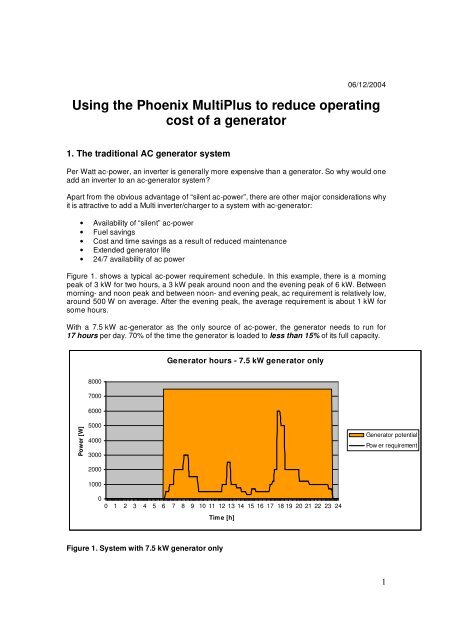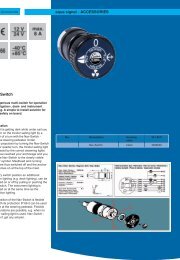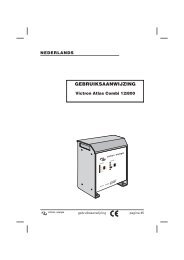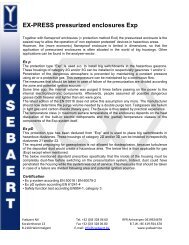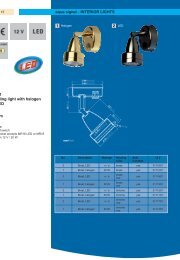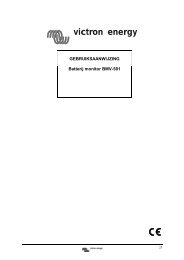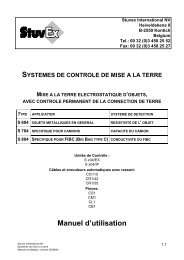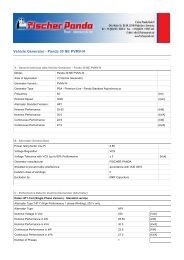Using the Phoenix MultiPlus to reduce operating cost of a ... - Ysebaert
Using the Phoenix MultiPlus to reduce operating cost of a ... - Ysebaert
Using the Phoenix MultiPlus to reduce operating cost of a ... - Ysebaert
Create successful ePaper yourself
Turn your PDF publications into a flip-book with our unique Google optimized e-Paper software.
06/12/2004<strong>Using</strong> <strong>the</strong> <strong>Phoenix</strong> <strong>MultiPlus</strong> <strong>to</strong> <strong>reduce</strong> <strong>operating</strong><strong>cost</strong> <strong>of</strong> a genera<strong>to</strong>r1. The traditional AC genera<strong>to</strong>r systemPer Watt ac-power, an inverter is generally more expensive than a genera<strong>to</strong>r. So why would oneadd an inverter <strong>to</strong> an ac-genera<strong>to</strong>r system?Apart from <strong>the</strong> obvious advantage <strong>of</strong> “silent ac-power”, <strong>the</strong>re are o<strong>the</strong>r major considerations whyit is attractive <strong>to</strong> add a Multi inverter/charger <strong>to</strong> a system with ac-genera<strong>to</strong>r:• Availability <strong>of</strong> “silent” ac-power• Fuel savings• Cost and time savings as a result <strong>of</strong> <strong>reduce</strong>d maintenance• Extended genera<strong>to</strong>r life• 24/7 availability <strong>of</strong> ac powerFigure 1. shows a typical ac-power requirement schedule. In this example, <strong>the</strong>re is a morningpeak <strong>of</strong> 3 kW for two hours, a 3 kW peak around noon and <strong>the</strong> evening peak <strong>of</strong> 6 kW. Betweenmorning- and noon peak and between noon- and evening peak, ac requirement is relatively low,around 500 W on average. After <strong>the</strong> evening peak, <strong>the</strong> average requirement is about 1 kW forsome hours.With a 7.5 kW ac-genera<strong>to</strong>r as <strong>the</strong> only source <strong>of</strong> ac-power, <strong>the</strong> genera<strong>to</strong>r needs <strong>to</strong> run for17 hours per day. 70% <strong>of</strong> <strong>the</strong> time <strong>the</strong> genera<strong>to</strong>r is loaded <strong>to</strong> less than 15% <strong>of</strong> its full capacity.Genera<strong>to</strong>r hours - 7.5 kW genera<strong>to</strong>r only800070006000Power [W]5000400030002000100000 1 2 3 4 5 6 7 8 9 10 11 12 13 14 15 16 17 18 19 20 21 22 23 24Time [h]Genera<strong>to</strong>r potentialPow er requirementFigure 1. System with 7.5 kW genera<strong>to</strong>r only1
2. Adding a Victron <strong>MultiPlus</strong> <strong>to</strong> <strong>the</strong> systemWe now introduce a Victron <strong>Phoenix</strong> <strong>MultiPlus</strong> 24/3000/70 inverter/charger and a battery bank <strong>to</strong><strong>the</strong> system. (see appendix for <strong>MultiPlus</strong> schematic) The inverter can supply <strong>the</strong> required acpowermost <strong>of</strong> <strong>the</strong> time. During <strong>the</strong> peak ac-requirement, <strong>the</strong> genera<strong>to</strong>r is started (preferablyau<strong>to</strong>matically by <strong>the</strong> Multi and/or a battery moni<strong>to</strong>r) <strong>to</strong> supply peak ac demand. At <strong>the</strong> same time,<strong>the</strong> <strong>MultiPlus</strong> will use any ac-power from <strong>the</strong> genera<strong>to</strong>r which is not required by <strong>the</strong> ac-loads, <strong>to</strong>re-charge <strong>the</strong> batteries.Figure 2 shows <strong>the</strong> same system now with <strong>the</strong> Victron <strong>MultiPlus</strong> added. Genera<strong>to</strong>r running hourscan be <strong>reduce</strong>d <strong>to</strong> 5 hours/day, while 12 hours <strong>of</strong> ac-consumption are enjoyed in silence.Whenever <strong>the</strong> genera<strong>to</strong>r is running, it is loaded up <strong>to</strong> 70% <strong>of</strong> its capacity.7.5 kW genera<strong>to</strong>r with Victron Multi Inverter / Charger(without PowerControl a 10 kW genera<strong>to</strong>r would be needed)80006000Genera<strong>to</strong>r powerInverter / ChargerPower requirement4000Power [W]20000-2000-40000 1 2 3 4 5 6 7 8 9 10 11 12 13 14 15 16 17 1819 20 21 22 23 24Time [h]Charge current <strong>reduce</strong>sbecause batteries arenearly fully chargedCharge current isau<strong>to</strong>matically <strong>reduce</strong>d inorder <strong>to</strong> prevent overload<strong>of</strong> <strong>the</strong> genera<strong>to</strong>r, seesection 3Figure 2. System with 7.5 kW genera<strong>to</strong>r and Victron <strong>MultiPlus</strong>. The blue line shows <strong>the</strong> powerthrough <strong>the</strong> Victron Multi. When <strong>the</strong> blue line is above 0, <strong>the</strong> inverter <strong>of</strong> <strong>the</strong> Multi takes power from<strong>the</strong> batteries <strong>to</strong> supply ac-power <strong>to</strong> <strong>the</strong> ac-loads. When <strong>the</strong> blue line is below 0, <strong>the</strong> charger <strong>of</strong> <strong>the</strong>Multi takes ac-power from <strong>the</strong> genera<strong>to</strong>r <strong>to</strong> re-charge <strong>the</strong> batteries.2.1 The BatteryThe battery size needed is smaller than what may be expected.In our example a 24 V battery would be discharged <strong>to</strong> 166 Ah just before <strong>the</strong> genera<strong>to</strong>r is startedin <strong>the</strong> morning, and <strong>to</strong> 285 Ah just before <strong>the</strong> genera<strong>to</strong>r is started in evening.A 24 V / 600 Ah battery would <strong>the</strong>refore be a good choice, with ample reserve capacity.If a 48 V system is chosen, 300 Ah will be needed.The most rugged battery for <strong>the</strong> purpose is <strong>the</strong> type used in forklift trucks.2
2.2. Fuel consumptionThe typical 7.5 kW genera<strong>to</strong>r will consume about 1.5 l/h diesel at low load and 2.3 l/h at 75%load. So <strong>the</strong> genera<strong>to</strong>r only configuration requires 25.5 liters diesel per day, whereas <strong>the</strong>genera<strong>to</strong>r with <strong>the</strong> Victron Multi requires 11.5 l/day <strong>to</strong> provide <strong>the</strong> same ac power. A savings <strong>of</strong>5110 liters diesel per year. At Euro 0.50 per liter, this equates <strong>to</strong> a savings <strong>of</strong> about Euro 2555per year (not counting time and money saved on re-fuelling).2.3. Periodic maintenanceTypical recommendation by <strong>the</strong> manufacturers is <strong>to</strong> change oil every 150 h <strong>of</strong> operation. For <strong>the</strong>genera<strong>to</strong>r-only scenario with 6205 running hours, this equates <strong>to</strong> 41 oil changes per year.When <strong>the</strong> Multi inverter / charger is added <strong>to</strong> <strong>the</strong> system, running time is <strong>reduce</strong>d <strong>to</strong> 1825 hours,this equates <strong>to</strong> 12 oil changes per year. A savings <strong>of</strong> 29 oil changes per year.At a typical lube oil volume <strong>of</strong> 5 l, 145 liter <strong>of</strong> lube oil is saved each year. At Euro 5.00 per liter,this equates <strong>to</strong> a savings <strong>of</strong> Euro 725 per year (not counting time involved in performing <strong>the</strong> oilchange and parts such as oil filters).2.4. Genera<strong>to</strong>r lifeGenera<strong>to</strong>rs based on a fixed speed diesel engine will last longer when <strong>the</strong>y are run under loadcompared <strong>to</strong> being run at no- or low load. Some manufacturers recommend operation at aminimum <strong>of</strong> 30% load <strong>to</strong> prevent premature failure.By adding <strong>the</strong> Multi inverter/charger in our example, <strong>the</strong> load on <strong>the</strong> genera<strong>to</strong>r went up from lessthan 15% for 70% <strong>of</strong> <strong>the</strong> time, <strong>to</strong> a loading <strong>of</strong> 70%. A considerable longer genera<strong>to</strong>r life may beexpected.2.5. SummaryGenera<strong>to</strong>r Only Genera<strong>to</strong>r with Multi SavingsRunning hours/day 17 h 5 h 12 h (silence)Diesel consumption/day 25.5 l/day 11.5 l/day 14 l/dayDiesel consumption/yr 9307 l/yr 4197 l/yr 5110 l/yrOil changes/yr 41 12 29Lube oil consumption/yr 205 l/yr 60 l/yr 145 l/yrGenera<strong>to</strong>r loading15% load for 70% <strong>of</strong> 70% loadrunning hoursAnnual savings in fuel and lubeEuro 3.280/yroil (3x longer service life <strong>of</strong><strong>the</strong> genera<strong>to</strong>r not included)Dollar savings after 5 yrs Euro 16.4002.6. ConclusionApart from <strong>the</strong> obvious benefit <strong>of</strong> availability <strong>of</strong> “silent” ac-power, <strong>the</strong> fuel savings and cut-down inmaintenance are significant when a Multi inverter/charger is added <strong>to</strong> <strong>the</strong> genera<strong>to</strong>r system. Also,not covered in this brief, <strong>the</strong> environmental impact as a result <strong>of</strong> reduction in harmful exhaust andoil waste will be significant.Actual gain will vary per genera<strong>to</strong>r and actual power requirement pr<strong>of</strong>ile. In general, <strong>the</strong> benefitswill be larger when <strong>the</strong> ac-requirement pr<strong>of</strong>ile shows a pattern <strong>of</strong> a few high peaks withsignificantly lower average power requirements between <strong>the</strong> peaks, which is a common pr<strong>of</strong>ile formost ac genera<strong>to</strong>r systems.3
3. Why should <strong>the</strong> inverter/charger be a Victron <strong>MultiPlus</strong>?In <strong>the</strong> previous section we saw that <strong>the</strong>re are potentially huge benefits and <strong>cost</strong> savings <strong>to</strong> bemade when an inverter/charger is added <strong>to</strong> a system with ac-genera<strong>to</strong>r. There are manyinverter/chargers on <strong>the</strong> market that <strong>cost</strong> a lot less than a Victron <strong>MultiPlus</strong>. In this section we willshow that, <strong>to</strong> take full advantage <strong>of</strong> <strong>the</strong> potential benefits, <strong>the</strong> inverter/charger must be a Victron<strong>MultiPlus</strong>.Apart from obvious benefits such as <strong>the</strong> clean pure sine wave output, ultra fast ac-transfer switch,marinized construction, high quality built and an organization behind <strong>the</strong> product which has beencommitted <strong>to</strong> R&D and cus<strong>to</strong>mer support for over 30 years, <strong>the</strong>re are five specific features <strong>of</strong> <strong>the</strong><strong>MultiPlus</strong> that are essential in achieving <strong>cost</strong> savings when using <strong>the</strong> inverter/charger with <strong>the</strong> acgenera<strong>to</strong>r.3.1. AC input power managerUnique <strong>to</strong> <strong>the</strong> Victron <strong>MultiPlus</strong> is <strong>the</strong> ability <strong>to</strong> set a power level that <strong>the</strong> unit will try <strong>to</strong> maintain atits ac-input terminals. The <strong>MultiPlus</strong> has 2 levels <strong>of</strong> ac power management. The first level isPowerControl.PowerControlThe PowerControl functionality enables <strong>the</strong> <strong>MultiPlus</strong> <strong>to</strong> au<strong>to</strong>matically increase and decrease <strong>the</strong>charge rate <strong>of</strong> its charger depending on <strong>the</strong> power demand at <strong>the</strong> ac-output <strong>of</strong> <strong>the</strong> Multi. ThePowerControl functionality <strong>of</strong> <strong>the</strong> input power manager is best unders<strong>to</strong>od by looking moreclosely at fig. 2.The blue line shows <strong>the</strong> power through <strong>the</strong> Victron Multi. When <strong>the</strong> blue line is above 0, <strong>the</strong>inverter <strong>of</strong> <strong>the</strong> Multi takes power from <strong>the</strong> batteries <strong>to</strong> supply ac-power <strong>to</strong> <strong>the</strong> ac-loads. When <strong>the</strong>blue line is below 0, <strong>the</strong> charger <strong>of</strong> <strong>the</strong> Multi takes ac-power from <strong>the</strong> genera<strong>to</strong>r <strong>to</strong> re-charge <strong>the</strong>batteries. This ac-power is an additional load <strong>of</strong> 2.2 kW for <strong>the</strong> genera<strong>to</strong>r. As can be concludedfrom fig. 1, this additional load would result in an overload <strong>of</strong> <strong>the</strong> genera<strong>to</strong>r between 18 hours and19 hours, because <strong>the</strong> o<strong>the</strong>r ac loads do increase <strong>to</strong> 6 kW during that period (see fig. 1). Adding<strong>the</strong> 2.2 kW load <strong>of</strong> <strong>the</strong> charger would increase <strong>the</strong> load <strong>to</strong> 6 + 2.2 = 8.2 kW. This overload wouldstall <strong>the</strong> 7.5 kW genera<strong>to</strong>r.To prevent this, <strong>the</strong> input power manager <strong>of</strong> <strong>the</strong> <strong>MultiPlus</strong> will au<strong>to</strong>matically <strong>reduce</strong> its charge ratein order <strong>to</strong> limit <strong>the</strong> <strong>to</strong>tal load on <strong>the</strong> genera<strong>to</strong>r <strong>to</strong> <strong>the</strong> set maximum power level, 6.5 kW in thisexample.If you are still reading, you are ei<strong>the</strong>r an enthusiast or pr<strong>of</strong>essionally involved with power systems.In that case we will let you in on one <strong>of</strong> our best-kept secrets.PowerAssist: <strong>the</strong> secret <strong>of</strong> <strong>the</strong> <strong>MultiPlus</strong>Figure 3 shows again our example power schedule with <strong>the</strong> 6 kW peak in <strong>the</strong> evening.But now <strong>the</strong> genera<strong>to</strong>r has been downsized <strong>to</strong> 5 kW.Choosing a smaller genera<strong>to</strong>r will <strong>of</strong> course <strong>reduce</strong> noise, size, weight, fuel consumption andinitial investment.The 5 kW genera<strong>to</strong>r will however not be able <strong>to</strong> supply <strong>the</strong> peak load <strong>of</strong> 6 kW, even if <strong>the</strong> chargecurrent <strong>of</strong> <strong>the</strong> <strong>MultiPlus</strong> is <strong>reduce</strong>d <strong>to</strong> zero during that period.Now PowerAssist, <strong>the</strong> second level <strong>of</strong> ac power management is needed. With PowerAssist <strong>the</strong><strong>MultiPlus</strong> can temporarily supplement <strong>the</strong> genera<strong>to</strong>r ac-power with power from <strong>the</strong> battery. Infigure 3 this is visible between 18 hours and 19 hours: even though <strong>the</strong> genera<strong>to</strong>r is running, <strong>the</strong><strong>MultiPlus</strong> is inverting (blue line above 0) instead <strong>of</strong> charging, thus providing <strong>the</strong> additional acpowerthat is required on <strong>to</strong>p <strong>of</strong> <strong>the</strong> genera<strong>to</strong>r output.With one <strong>MultiPlus</strong> 24/3000/70 an additional 3 kW can be added <strong>to</strong> <strong>the</strong> genera<strong>to</strong>r output!4
5 kW genera<strong>to</strong>r with Victron <strong>MultiPlus</strong>80006000genera<strong>to</strong>r potential<strong>MultiPlus</strong> powerpower requirementPower [W]40002000PowerAssist: <strong>the</strong><strong>MultiPlus</strong> ads power<strong>to</strong> <strong>the</strong> genera<strong>to</strong>routput.00 1 2 3 4 5 6 7 8 9 10 11 12 13 14 15 16 17 1819 20 21 22 23 24-2000-4000Time [h]Figure 3. System with 5 kW genera<strong>to</strong>r and <strong>MultiPlus</strong> inverter/charger. When <strong>the</strong> blue line(<strong>MultiPlus</strong>) is below 0, energy is put in<strong>to</strong> <strong>the</strong> battery bank (charging), when <strong>the</strong> blue line is above0, <strong>the</strong> <strong>MultiPlus</strong> is generating ac from <strong>the</strong> battery bank (inverting).Dynamic range <strong>of</strong> ac power regulationIn <strong>the</strong> previous sections, we saw that <strong>the</strong> key <strong>to</strong> achieving savings by adding an inverter/charger<strong>to</strong> a genera<strong>to</strong>r system was <strong>the</strong> ability <strong>of</strong> <strong>the</strong> inverter/charger <strong>to</strong> dynamically control <strong>the</strong> ac powertaken from <strong>the</strong> genera<strong>to</strong>r.With <strong>the</strong> <strong>MultiPlus</strong>, 24/3000/70 <strong>the</strong> dynamic range <strong>of</strong> ac power regulation is more than 5 kW:The first level <strong>of</strong> dynamic ac power regulation is PowerControl, which enables control <strong>of</strong> <strong>the</strong> acpower needed for battery charging between zero and a maximum power draw <strong>of</strong> about 2.3 kW.(= 70 A charge current times 30 V charge voltage at 90% efficiency)On <strong>to</strong>p <strong>of</strong> that PowerAssist, <strong>the</strong> second level <strong>of</strong> dynamic ac power regulation, extends powerregulation with an additional 3kW (per unit), which may be above <strong>the</strong> maximum power <strong>of</strong> <strong>the</strong>genera<strong>to</strong>r. This implies that using a <strong>MultiPlus</strong> is particularly useful when <strong>the</strong> ac-powerrequirement pr<strong>of</strong>ile shows large variations (high peaks short in duration, low average), thatrequire a wide dynamic range <strong>of</strong> ac-power regulation.3.2 Unity power fac<strong>to</strong>rSimply said, <strong>the</strong> power fac<strong>to</strong>r <strong>of</strong> an ac-load is an indication <strong>of</strong> how much power needs <strong>to</strong> besupplied <strong>to</strong> <strong>the</strong> load relative <strong>to</strong> <strong>the</strong> power that <strong>the</strong> load consumes. The power consumed by <strong>the</strong>load is indicated in Watts, <strong>the</strong> power that needs <strong>to</strong> be supplied is indicated in VA. If <strong>the</strong> Powerfac<strong>to</strong>r is PF, <strong>the</strong> following relationship exists:P W = PF x P VA. The power in VA is equal <strong>to</strong> <strong>the</strong> product <strong>of</strong> rms voltage and rms current.5
The power fac<strong>to</strong>r <strong>of</strong> some battery chargers can be as low as 0.7. This means that a charger thatconsumes 2 kW, requires about 2.8 kVA from <strong>the</strong> genera<strong>to</strong>r <strong>to</strong> make it work. If <strong>the</strong> genera<strong>to</strong>rvoltage is 230 V, <strong>the</strong> genera<strong>to</strong>r must be able <strong>to</strong> supply 12.2 A <strong>to</strong> this charger. The genera<strong>to</strong>rwould only need <strong>to</strong> supply 8.6 A for <strong>the</strong> same charge result if <strong>the</strong> power fac<strong>to</strong>r were <strong>to</strong> be 1.One cause <strong>of</strong> non-unity power fac<strong>to</strong>r is that load current is not in phase with <strong>the</strong> voltage. Theo<strong>the</strong>r major cause <strong>of</strong> non-unity power fac<strong>to</strong>r is a load current that is not sinusoidal. A nonsinusoidalload current will cause harmonic dis<strong>to</strong>rtion in <strong>the</strong> ac system. Harmonic dis<strong>to</strong>rtion cancause genera<strong>to</strong>r windings <strong>to</strong> burn out.To cope with <strong>the</strong> negative effects <strong>of</strong> non-unity power fac<strong>to</strong>r and non-sinusoidal current <strong>of</strong> mostchargers, genera<strong>to</strong>r suppliers will recommend <strong>to</strong> oversize <strong>the</strong> genera<strong>to</strong>r by as much as a fac<strong>to</strong>r <strong>of</strong>2 (note that only <strong>the</strong> genera<strong>to</strong>r needs <strong>to</strong> be oversized, not <strong>the</strong> diesel engine driving it).The Victron <strong>MultiPlus</strong> inverter/charger has a unity power fac<strong>to</strong>r (PF = 1). A system with Multiesdoes not require over sizing <strong>to</strong> cope with <strong>the</strong> chargers. It fur<strong>the</strong>rmore will not introduce harmonicdis<strong>to</strong>rtion in<strong>to</strong> <strong>the</strong> system. These are very important considerations when planning <strong>to</strong> add aninverter/charger <strong>to</strong> a genera<strong>to</strong>r system.3.3 ScalingThird reason <strong>to</strong> choose a Victron Multi, is because this is <strong>the</strong> only inverter/charger on <strong>the</strong> marketthat allows easy scaling <strong>of</strong> <strong>the</strong> system. A single 3 kW inverter/charger will have little impact on a40 kW genera<strong>to</strong>r system. Because <strong>the</strong> Victron Multi is a modular unit, systems <strong>of</strong> up <strong>to</strong> 15 kWsingle phase or 45 kW 3-phase can easily be built by adding more units. The <strong>to</strong>tal system caneasily be scaled for optimum performance / savings. (see fig. 4)Figure 4: System with 5 Multies in parallel, a genera<strong>to</strong>r and an alternative supply.6
Note:At <strong>the</strong> o<strong>the</strong>r side <strong>of</strong> <strong>the</strong> power spectrum, A <strong>MultiPlus</strong> can also be used <strong>to</strong> boost <strong>the</strong> output <strong>of</strong> smallgensets like <strong>the</strong> Honda “I” range for example. (The “I” range starts at 1 kVA)3.4 External ac power management moduleIn <strong>the</strong> examples <strong>of</strong> fig. 2 and fig. 3 genera<strong>to</strong>rs with 7.5 kW and 5 kW output power were used.In case <strong>of</strong> larger systems (see fig. 4) with multiple paralleled Multies, it becomes unpractical <strong>to</strong>use <strong>the</strong> internal ac power management module <strong>of</strong> <strong>the</strong> Multies.For larger systems an external current measuring system has been built in <strong>the</strong> PowerManager,and soon an even more sophisticated ac power management module will become available.3.5 Connectivity: a continuously increasing array <strong>of</strong> moni<strong>to</strong>ring and control facilitiesNext <strong>to</strong> <strong>the</strong> Multi Control panel and VEConfigure, VE.Bus and VE.Net connectivity will soon makeany requirement regarding remote control (including mobile phone and satellite) a reality.4. ConclusionIn <strong>the</strong> second section, we showed that adding an inverter charger <strong>to</strong> an ac-genera<strong>to</strong>r systemcould have huge potential benefits such as silent ac supply, fuel savings, maintenance reductionand extended genera<strong>to</strong>r life.In <strong>the</strong> third section we saw that <strong>to</strong> be able <strong>to</strong> achieve <strong>the</strong>se potential benefits, <strong>the</strong> inverter/chargermust have certain specific features that are found only on <strong>the</strong> Victron <strong>MultiPlus</strong>: au<strong>to</strong>matic acinput power control, unity power fac<strong>to</strong>r and modularity for scaling.7
Appendix : schematic diagram <strong>of</strong> <strong>the</strong> <strong>MultiPlus</strong>The bidirectional converterThe M/M+ is built around a bidirectional converter, that operates as an inverter or as a batterycharger.The converter <strong>of</strong> <strong>the</strong> M+ does more than a conventional bidirectional converter: it operates inparallel with <strong>the</strong> grid, with shore power or with a genset. It can add power <strong>to</strong> AC supply (wi<strong>the</strong>nergy from <strong>the</strong> battery) and it will use surplus power <strong>to</strong> recharge. In most cases <strong>the</strong> M+ willalso <strong>reduce</strong> <strong>the</strong> harmonic dis<strong>to</strong>rtion <strong>of</strong> <strong>the</strong> genset output (this can be important for certainsensitive loads such as an induction cooker)A multifunctional relayThis relay can a. o. be programmed <strong>to</strong> start a genera<strong>to</strong>r based on power demand and / orbattery voltage.A RS485 portAll parameters <strong>of</strong> <strong>the</strong> M/M+ are programmable.The most important parameters can be programmed with a push but<strong>to</strong>n code, but it is muchmore convenient <strong>to</strong> use <strong>the</strong> MK.1b RS485 <strong>to</strong> RS232 converter, VEConfigure s<strong>of</strong>tware(downloadable from our website) and a PC Notebook computer.Examples <strong>of</strong> programmable parameters:- inverter DC voltage cut out- charge curve- maximum charge current- parallel operation, split phase operation and 3 phase operation- programming <strong>the</strong> multifunctional relay8
Connec<strong>to</strong>r for parallel operation and 3 phase operationUp <strong>to</strong> 6 Multi’s can be parallel connected <strong>to</strong> increase power <strong>to</strong> 15 kW.In 3 phase configuration up <strong>to</strong> 18 Multi’s can be used <strong>to</strong> build a 45 kW inverter / charger!AC input with 16 Amp <strong>the</strong>rmal breaker and safety relayThe maximum AC input current <strong>of</strong> <strong>the</strong> M/M+ is 16 A. (optional 32 A).06/12/200406/12/2004The safety relay makes sure that no dangerous AC voltage will be present on for example <strong>the</strong>shore power plug when disconnected.The Multi Control Panel (16 A or 30 A)The rotary knob on this panel is crucial: with this knob <strong>the</strong> maximum AC input current can beset, <strong>to</strong> a maximum <strong>of</strong> 16 A or 32 A.9


